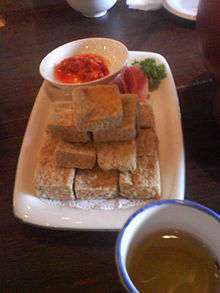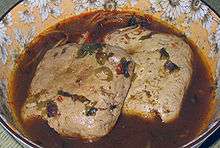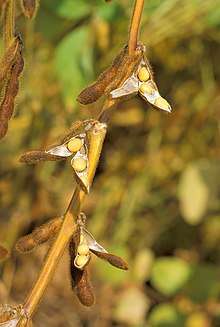Stinky tofu
 | |
| Place of origin | China |
|---|---|
| Main ingredients | fermented tofu |
| Stinky tofu | |||||||||||||||||||||||
| Chinese | 臭豆腐 | ||||||||||||||||||||||
|---|---|---|---|---|---|---|---|---|---|---|---|---|---|---|---|---|---|---|---|---|---|---|---|
| Literal meaning | stinky tofu | ||||||||||||||||||||||
| |||||||||||||||||||||||
Stinky tofu (Chinese: 臭豆腐; pinyin: chòudòufu) is a Chinese form of fermented tofu that has a strong odor. It is usually sold at night markets or roadside stands as a snack, or in lunch bars as a side dish, rather than in restaurants.
Production
Unlike cheese, stinky tofu fermentation does not have a fixed formula for starter bacteria; wide regional and individual variations exist in manufacturing and preparation.
The traditional method of producing stinky tofu is to prepare a brine made from fermented milk, vegetables, and meat; the brine can also include dried shrimp, amaranth greens, mustard greens, bamboo shoots, and Chinese herbs.[1] The brine fermentation can take as long as several months.
Modern factories often use quicker methods to mass-produce stinky tofu. Fresh tofu is marinated in prepared brine for only a day or two, especially for fried or boiled cooking purposes.[2] The process only adds odor to the marinated tofu instead of letting it ferment completely.
Preparation

Stinky tofu can be eaten cold, steamed, stewed, or, most commonly, deep-fried, and it is often accompanied by chili sauce or soy sauce. The color varies from the golden, fried Zhejiang-style to the black, typical of Hunan-style stinky tofu.[1]
From a distance, the odor of stinky tofu is said to resemble that of rotten garbage or smelly feet.[3] Some people have compared it to the taste of blue cheese,[4] while others have compared it to rotten meat. It is said that the more it smells, the better its flavor.[1]
History
According to a Chinese legend, a scholar named Wang Zhihe (王致和) hailing from Huang Shan in Anhui Province invented stinky tofu during the Qing dynasty.[5][6] After failing the imperial examination, Wang stayed in Beijing and relied on selling tofu to make a living. One day, having a huge quantity of unsold tofu on his hands, he cut the tofu into small cubes and put them into an earthen jar.[7] After several days, he opened up the jar and found out that the tofu had turned greenish and become extremely smelly. Initially perceiving the tofu to taste extremely foul, he found out that it was surprisingly delicious so he decided to start selling it at his store.[8] The stinky tofu that Wang Zhihe invented gained popularity and was later served at the imperial Qing Dynasty palace. The Empress Cixi later named the delicacy "imperial green cubes".[9][10]
Chemical analysis
A 2012 chemical analysis found 39 volatile organic compounds that contributed to the unique smell and taste of fermented stinky tofu. The main volatile compound was indole, followed by dimethyl trisulfide, phenol, dimethyl disulfide and dimethyl tetrasulfide.[11]
Around the world
Mainland China
Stinky tofu is made and consumed in different ways in various areas of China. For example, the types of dried stinky tofu made in Changsha and Shaoxing are made using different methods, and the resulting flavors are very different. Huo Gong Dian (a stinky tofu shop in Changsha) makes the tofu with yellow soybeans marinated in seasoning. The stinky tofu sold in Tianjin is made mostly in the Nanjing style, with a mild aroma. In Shanghai, stinky tofu is fried and sold on the street, typically served with a spicy or sweet sauce much like the Shaoxing variety. It is also served as a condiment to congee, often as a part of a regular breakfast meal. In Chongqing, stinky tofu on the street is usually fried and dipped in a mixture of, typically, coriander (cilantro) leaves, scallions, chili powder, Sichuan pepper and oil. Stinky tofu is also sometimes dipped in Sichuan spicy hot pot. In Beijing, there is a form that is sold in jar as a curd.
In Anhui, the deliciousness of stinky tofu depends mainly on its spiciness. The spicier it is, the more it suits the local favor.[12]
Hong Kong
In Hong Kong, stinky tofu is a street food. It is deep-fried fresh at hawkers' stalls and at dai pai dongs and sold by the bag. Hong Kong-style stinky tofu is traditionally eaten with hoisin sauce. Unlike the diversity of stinky tofu in Taiwan, in Hong Kong it is usually deep-fried. Rather than eating deep-fried stinky tofu with pickled vegetables, Hongkongers usually enjoy deep-fried stinky tofu with sweet sauce and chili sauce.
Taiwan
Stinky tofu is usually served deep-fried (often served drizzled with sauce and topped with sour pickled vegetables), grilled, or added to a Sichuan mala soup base (with solid goose blood, pickled mustard greens, and pork intestines).
Deep-fried stinky tofu
Deep fried stinky tofu is a common dish in both Taiwanese night markets and restaurants. Before the 1990s, hawkers even wandered around the street and peddled deep-fried stinky tofu. In Taiwan, people usually eat the deep-fried stinky tofu (often sold from carts) with the local sweet-and-sour pickled cabbage, believed to relieve the greasiness.
Spicy stinky tofu
Spicy stinky tofu is a new cooking method for stinky tofu in Taiwan. Because of the prevalence of spicy hot pot, Taiwanese people came up with a new idea of forming a rich-flavored spicy hot pot soup base by using stinky tofu, duck blood and Chinese sauerkraut as ingredients. This innovative cooking method of stinky tofu is now popular in Taiwanese culture.
Soft stinky tofu
Soft Stinky tofu is commonly used as a condiment for rice, bread, congee or noodles. It can also be used as a seasoning for cooking.
Barbecued stinky tofu
Barbecued stinky tofu is a popular stinky tofu variety believed to be from Taipei's Shenkeng District, and is served in many of Taiwan's night markets. Cubes of stinky tofu are speared on a bamboo skewer are roasted over charcoal with roasted meat sauce. Because of the huge amount of seasonings, the unpleasant odor of barbecued stinky tofu is comparatively weaker. Therefore, barbecued stinky tofu is always recommended for people trying stinky tofu for the first time.
United States
Taiwanese-style stinky tofu can also be found in specialty restaurants in some parts of the United States.[3][13]
See also
References
- 1 2 3 Xiaomi, Tan (2 June 2006). "Stand back! Stinky tofu chain stores arrive in Shenzhen". Shenzhen Daily. Archived from the original on 28 August 2013.
- ↑ "臭豆腐秘密基地 直擊製作過程!". 華視新聞網.
- 1 2 Nguyen, C. Thi (2011-11-10). "The Find: Stinky tofu restaurant may find converts". Los Angeles Times. ISSN 0458-3035. Retrieved 2018-09-15.
Tofu King has opened a second eatery in Arcadia, which is good news to those seeking the Taiwanese, deep-fried fermented dish. [...] But this is not a masochist's stinky tofu. This is a subtle, carefully controlled, artful bit of fermented snackery. The stuff is almost delicate. If blue cheeses and stinky tofus are the foods that smell like feet, this stinky tofu smells like Natalie Portman's feet — at least in a fanboy's imagination. [...] The original Rowland Heights branch of Tofu King reigns over a small shopping mall alleyway food court. [...] The original branch is still around and is still tops for old-school Chinese night-market, street-food charm, but for maximum culinary pleasure, follow Mel Chang to the new Arcadia branch.
- ↑ Lennox, Craig (28 January 2010). "Chou doufu: the origins of stinky tofu". Global Times. Archived from the original on 30 April 2010. Retrieved 14 July 2010.
- ↑ Ezrati, Or (23 October 2012). "This Wonder, This Miracle, This Stinky Tofu". Haaretz.
- ↑ "Stinky Tofu (Chou Doufu-臭豆腐)". ChinaDictionary.net. 29 January 2015. Missing or empty
|url=(help) - ↑ "Kaleidoscope: Food Culture: Wang Zhihe Fermented Bean Curd". kaleidoscope.cultural-china.com. Archived from the original on 18 April 2015. Retrieved 14 September 2018.
- ↑ Fredericson, Colin (23 June 2016). "Stinky Tofu: The Chinese Dish That Smells Awful, but Tastes Heavenly". Vision Times. Missing or empty
|url=(help) - ↑ "Stinky Tofu (Chou Doufu-臭豆腐)". ChinaDictionary.net. 29 January 2015. Missing or empty
|url=(help) - ↑ Ku, Henry (13 December 2013). "Stinky Tofu in Seattle: Why You Should Try This Strange Snack". Henry's Taiwan Kitchen.
- ↑ Liu, Y; Miao, Z; Guan, W; Sun, B (26 Mar 2012). "Analysis of Organic Volatile Flavor Compounds in Fermented Stinky Tofu Using SPME with Different Fiber Coatings". Molecules. 17 (4): 3708–3722. doi:10.3390/molecules17043708. PMID 22450681.
- ↑ "Yahoo雅虎香港". Retrieved 1 March 2015.
- ↑ Sakai, Shuji (2013-07-09). "Tofu King Opens in Irvine". OC Weekly. Retrieved 2018-09-15.
The Orange Tree Square Shopping Center, a small shopping center backed up hard against the 5 freeway at Jeffrey Road, gains another strong player in the cuisine of that nation. This is the first Orange County location of Tofu King, which has other shops in Rowland Heights and Arcadia. It joins other Taiwanese heavyweights as 101 Noodle Express, Liang's Kitchen, Yu's Garden, Home Town Deli, and Lao Dong Beef Noodles.
External links


